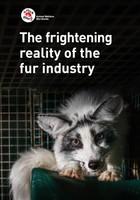
Think Fur is Green? Think Again!
Why fur is not the eco-friendly choice
Breeding animals for their fur is inefficient and highly energy-consumptive. Claims that fur is sustainable have been debunked and the fur industry has been penalised several times for misleading advertisements making claims of sustainability[1].

Toxic chemicals polluting the environment
To make the raw animal skins suitable for fashion, heavily toxic chemicals such as chromium and formaldehyde are used to keep them from rotting. This is known as fur ‘dressing’ and is similar to leather tanning.
Extensive international research has pointed out that toxins in fur pose a serious health risk. High levels of chemicals as formaldehyde and ethoxylates are found in most fur trims, which can cause allergies, cancer and hormonal imbalance.
Fur farms release significant amounts of animal manure into local waterways, polluting soil and waterways, and contributing to nitrogen and phosphorus pollution[2], and eutrophication[3].
Fur production has a higher carbon footprint
Similarly, studies that have addressed the environmental impact of the fur industry refute claims that fur is ‘green’ or preferable to other textiles[4].
Fur is far more damaging to the environment in comparison to other textiles, including synthetics[5].
- It is estimated that to produce a real fur coat from farmed animals demands over 15 times more energy than that needed to produce a fake fur garment[6].
- For each kilogram of factory-farmed mink fur, almost 150 kilograms of carbon dioxide is produced, which is over five times higher than other energy intensive textiles[7].
Negative impact on biodiversity
The hunting practices of the fur industry also negatively impact on biodiversity. The use of indiscriminate traps present a major threat to the survival of many native species, some of which are classified as endangered or threatened.
What’s more, animals such as the American mink and raccoon dogs, who were introduced in Europe for fur farming, are now listed as invasive species and a threat to native animals across Europe. See here.
Claims that fur is a natural and sustainable product are thus fiction instead of reality. The production of fur is intensely polluting and requires a lot of energy.
Progress for fur alternatives
Overall, great strides are being made to improve the sustainability of a wide range of materials and develop new ones, from plant-based fibres through to synthetics[8]. There are both new technologies and new eco fibres being developed or already entering the market with potential for widespread use. But there are no such viable options for fur because factors such as feed, manure and dressing of fur and the associated pollution cannot be eliminated.

The Frightening Reality of the Fur Industry
Cruelty, COVID-19 and changing times – FOUR PAWS report calls for the end of Australia’s support of fur farming and its zoonotic risks
Source
[2] The impacts of the mink industry on freshwater lakes in Nova Scotia: An overview of concerns, 2011.
[3] Ibid.
[4] Marijn Bijleveld, Marisa Korteland, Maartje Sevenster, The environmental impact of mink fur production, 2011. The Fur Trade Federation’s (IFTF) commissioned report admits that a conclusion on whether fur is more environmentally friendly than synthetics cannot be made.
[5] Marijn Bijleveld, Marisa Korteland, Maartje Sevenster, The environmental impact of mink fur production, 2011.
[6] Ibid.
[7] Ibid.
[8] Fashion at a Crossroads Greenpeace Report, 2017; Jane Wood, Bioinspiration in Fashion—A Review, 2019.

